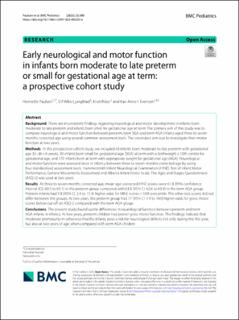| dc.contributor.author | Paulsen, Henriette | |
| dc.contributor.author | Ljungblad, Ulf Wike | |
| dc.contributor.author | Riiser, Kirsti | |
| dc.contributor.author | Evensen, Kari Anne Indredavik | |
| dc.date.accessioned | 2023-11-07T08:41:50Z | |
| dc.date.available | 2023-11-07T08:41:50Z | |
| dc.date.created | 2023-08-16T11:59:22Z | |
| dc.date.issued | 2023 | |
| dc.identifier.issn | 1471-2431 | |
| dc.identifier.uri | https://hdl.handle.net/11250/3100968 | |
| dc.description.abstract | Background
There are inconsistent findings regarding neurological and motor development in infants born moderate to late preterm and infants born small for gestational age at term. The primary aim of this study was to compare neurological and motor function between preterm, term SGA and term AGA infants aged three to seven months corrected age using several common assessment tools. The secondary aim was to investigate their motor function at two years.
Methods
In this prospective cohort study, we included 43 infants born moderate to late preterm with gestational age 32–36 + 6 weeks, 39 infants born small for gestational age (SGA) at term with a birthweight ≤ 10th centile for gestational age, and 170 infants born at term with appropriate weight for gestational age (AGA). Neurological and motor function were assessed once in infancy between three to seven months corrected age by using four standardised assessment tools: Hammersmith Infant Neurological Examination (HINE), Test of Infant Motor Performance, General Movements Assessment and Alberta Infant Motor Scale. The Ages and Stages Questionnaire (ASQ-2) was used at two years.
Results
At three to seven months corrected age, mean age-corrected HINE scores were 61.8 (95% confidence interval (CI): 60.5 to 63.1) in the preterm group compared with 63.3 (95% CI: 62.6 to 63.9) in the term AGA group. Preterm infants had 5.8 (95% CI: 2.4 to 15.4) higher odds for HINE scores < 10th percentile. The other test scores did not differ between the groups. At two years, the preterm group had 17 (95% CI: 1.9 to 160) higher odds for gross motor scores below cut-off on ASQ-2 compared with the term AGA group.
Conclusions
The present study found subtle differences in neurological function between preterm and term AGA infants in infancy. At two years, preterm children had poorer gross motor function. The findings indicate that moderate prematurity in otherwise healthy infants pose a risk for neurological deficits not only during the first year, but also at two years of age when compared with term AGA children. | en_US |
| dc.language.iso | eng | en_US |
| dc.publisher | BioMed Central Ltd. | en_US |
| dc.rights | Navngivelse 4.0 Internasjonal | * |
| dc.rights.uri | http://creativecommons.org/licenses/by/4.0/deed.no | * |
| dc.title | Early neurological and motor function in infants born moderate to late preterm or small for gestational age at term: a prospective cohort study | en_US |
| dc.title.alternative | Early neurological and motor function in infants born moderate to late preterm or small for gestational age at term: a prospective cohort study | en_US |
| dc.type | Peer reviewed | en_US |
| dc.type | Journal article | en_US |
| dc.description.version | publishedVersion | en_US |
| dc.source.volume | 23 | en_US |
| dc.source.journal | BMC Pediatrics | en_US |
| dc.identifier.doi | 10.1186/s12887-023-04220-w | |
| dc.identifier.cristin | 2167322 | |
| dc.source.articlenumber | 390 | en_US |
| cristin.ispublished | true | |
| cristin.fulltext | original | |
| cristin.qualitycode | 1 | |

